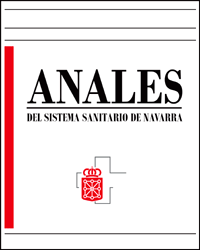Evaluación de las evidencias y calidad de las guías de práctica clínica sobre deterioro de la integridad cutánea: úlceras y heridas crónicas
DOI:
https://doi.org/10.23938/ASSN.0236Palabras clave:
Guía de Práctica Clínica. Úlcera por presión. Úlcera venosa. Pie diabético. Cuidados de Enfermería.Resumen
Fundamento. La situación epidemiológica, sociosanitaria y económica que rodea al deterioro de la integridad cutánea supone un gran problema para el sistema sanitario. Su prevención y tratamiento crea incertidumbre y variabilidad profesional siendo prioritario contar con buenas Guías de Práctica Clínica (GPC). El objetivo fue conocer la calidad de las GPC sobre prevención y tratamiento de úlceras por presión (UPP), úlceras venosas de la pierna (UVP) y úlceras de pie diabético (UPD).
Metodología. Revisión sistemática de la calidad de GPC españolas e internacionales sobre UPP, UVP y UPD. Búsqueda bibliográfica en fuentes especializadas. Selección de GPC con antigüedad no superior a 5 años (2010-2015). Uso del Instrumento AGREE II y revisión por 4 expertos. Estadística descriptiva.
Resultados. Veintitrés GPC (10 UPP, 6 UVP y 7 UPD); de ellas, 4 eran españolas y 19 internacionales. Fueron consideradas “muy recomendables” 8 GPC sobre UPP, 3 de UVP y 5 de UPD. El Dominio nº 2 (participación) y el Dominio nº 5 (aplicabilidad) fueron los peores valorados. La calidad de la evidencia fue “muy buena” en 19 GPC. La mejor GPC fue la inglesa de la NICE (UPP), la australiana de la AWMA (UVP) y la canadiense de la RNAO (UPD).
Conclusiones. Se observa una buena calidad metodológica en las GPC sobre UPP y UPD, pero habría que mejorar en las UVP. En general, habría que aumentar la participación de los usuarios, y describir las posibles barreras para la implementación de las GPC en la práctica clínica.
Descargas
Archivos adicionales
Publicado
Cómo citar
Número
Sección
Licencia
Derechos de autor 2016 Anales del Sistema Sanitario de Navarra

Esta obra está bajo una licencia internacional Creative Commons Atribución-CompartirIgual 4.0.
La revista Anales del Sistema Sanitario de Navarra es publicada por el Departamento de Salud del Gobierno de Navarra (España), quien conserva los derechos patrimoniales (copyright ) sobre el artículo publicado y favorece y permite la difusión del mismo bajo licencia Creative Commons Reconocimiento-CompartirIgual 4.0 Internacional (CC BY-SA 4.0). Esta licencia permite copiar, usar, difundir, transmitir y exponer públicamente el artículo, siempre que siempre que se cite la autoría y la publicación inicial en Anales del Sistema Sanitario de Navarra, y se distinga la existencia de esta licencia de uso.








